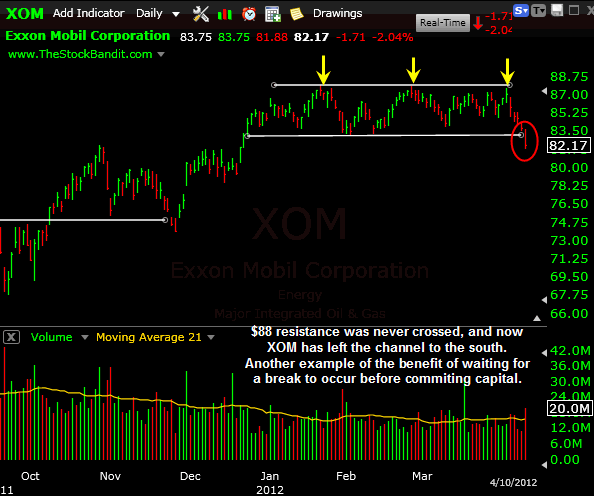Wait for the Trend Line Break!
As a pattern-based trader, I use a lot of trend lines on my charts. When you look at my charts, the only indicator you’ll see is the 21-period MA of volume, which is the running 1-month volume average. Beyond that, it’s just price, volume, and trend lines around the patterns I see in price.
I keep it simple.
Confirmation of those patterns is what I require before taking entries on 99% of my trades, which means price crossing through a trend line. The way I view it, until that line in the sand is crossed, nothing has changed. The rest phase or pullback must not be done until then. I may detect price perking up or volume percolating, but until the trend line breaks, the setup cannot be fully embraced as a positive change of character.
Right now there’s an excellent example in the chart of AMGN of why waiting for that trend line break can mean preserving both capital and clarity. The stock is bullish, no doubt about it, as the intermediate uptrend remains intact since it began last August. Since then, we have a series of higher highs and higher lows.
In recent weeks, the stock has been pulling back quietly with some minor profit-taking leaving price drifting lower since the early-February peak. The prior breakout was around $65 (January) so it could be the stock is in for a test of that zone, who is to say otherwise? And until a break occurs to suggest the stock is back on the move, who cares?
Currently, the stock is floundering around beneath a very valid trend line, but no less a trend line which has yet to be crossed.

XOM is another example here as just recently the widely-anticipated push through the $88 level as recently as last week never happened. The stock has since fallen out of its channel to the downside. Waiting was the best option.

F is one more on the list with $13.05 resistance never being crossed, despite approaching it multiple times of late. Those who bought early in hopes of getting in “cheaper” ahead of the breakout actually paid up. The stock has exited its trading range to the downside, leaving premature buyers in what I’d call the “hurtin for certain” department.

Traders by and large love to predict what’s coming, and often will take anticipatory trades as such. Doing so can be an expensive way to get caught in a stagnant name.
Carefully consider whether a stock is truly getting on the move before committing capital to entries. Could be that waiting a little longer provides you with not only better prices, but better defined exits as well.
Trade Like a Bandit!
Jeff White
Producer of The Bandit Broadcast
Get our free newsletter to keep up!
Follow @TheStockBandit







Arthuredayjr | Apr 11, 2012 | Reply
I can attest to this. This has always been my downfall. Even last week, thinking this was just a minor pullback and buying these dips has cost me thousands.
If you are disciplined and wait for the set ups, it is much easier. Makes me want to quit all together.
Jim | Apr 12, 2012 | Reply
A great post Jeff. As the previous poster mentioned disciple. Where can I buy some 🙂
Anonymous | Apr 12, 2012 | Reply
Hang in there Art, we all have those frustrating times. If you don’t see what you like, walk away or sit on hands…simple but not always easy.
Jim, thanks for your comment as well. I wish I knew! I will say this….discipline in other areas of life can help promote discipline in your trading. Look there and see what else might could use your attention, as I’ve found that is useful in my own trading.
fpetry, aka BamaPete | Jun 24, 2012 | Reply
Jeff, I have to disagree with you to a degree. Part of my method IS to make the anticipatory trade. But only with particular setups. Both of your chart examples are the type that imo beg for anticipatory trades, i.e. entering pre breakout. Let me use the F setup you show above.
* 2/27/12 support of 11.99 established at least short term with low for day.
* 3/6/12 day’s low is 12, lending credence to prior support of 11.99.
* The next day on the 7th price offers entry signal by moving above prior day’s high. Entry is made at 12.30, with a small sized position, say 1/3 size, with stop a few cents below prior day’s low of 12, say 11.90.
* No further adding to position unless breakout above range or channel high of 13.05. If price approaches range high the stop is trailed up locking in small profit sans large gap down. If price breaks out another signal to buy more. If breakout fails, strategically placed stop for entire position should at least ensure a breakeven or smaller loss courtesy cushion of first buy.
* In essence, this method is a combo of buying the pullback and the breakout for a single setup.
Enjoy your commentary and videos, and especially appreciate your clean and simple charts, pattern recognition, space bar is a great tool….I’m sure you get my drift there:)
BamaPete
Anonymous | Jun 25, 2012 | Reply
BamaPete,
Thanks for sharing your thoughts! Generally, waiting is a more timely entry than anticipating and it leaves capital exposed to risk only when a move is starting to take place. Getting in early can produce slightly better returns, but it comes with added risk and potentially being exposed longer without movement.
Even with your method on the trade you outlined, you’re only getting in a partial position before the break. I think if you’re anticipating, that’s the way to do it.
Thanks for reading and for your comments (and the nice words as well)!
Jeff